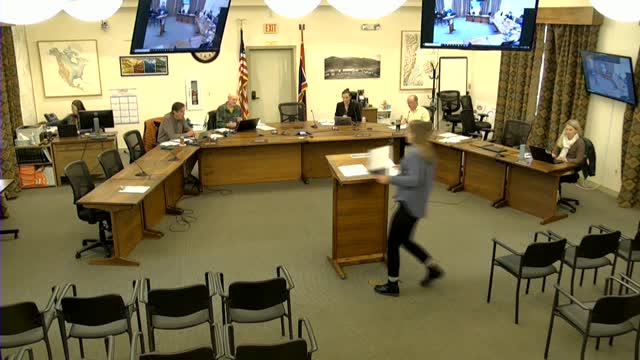Commissioners remand Hog Island zoning amendment to planning commission for further review
October 07, 2025 | Teton County, Wyoming
This article was created by AI summarizing key points discussed. AI makes mistakes, so for full details and context, please refer to the video of the full meeting. Please report any errors so we can fix them. Report an error »

The Teton County commissioners on Oct. 7 remanded a proposed amendment (AMD 2025‑1) affecting the Hog Island workforce home‑business zone back to the county planning commission for further review and guidance.
The applicant, Mountain Wyoming Capital LLC (doing business as Ridgeline Excavation), asked to add light and heavy industry as primary allowed uses on certain sites in the workforce home‑business overlay. Erin Monroe, associate long‑range planner, summarized staff edits and explained that the planning director recommends denial. Applicant representatives, including John Graham and Alex Jordan, argued the amendment would create a pathway for businesses that provide essential local services to operate lawfully and could reduce unregulated nonconforming uses.
Neighbors and stakeholders raised concerns about the proposal’s impact on neighborhood character, enforcement history and groundwater quality. Public commenters included Norris Brown and Elizabeth Eastman, who urged consistency with existing LDR enforcement and emphasized that maintaining owner‑occupied primary residences is central to the workforce home‑business zone’s purpose. Protect Our Water Jackson Hole and Snake River Fund submitted comments and asked the commission to evaluate water‑quality risks.
After extended discussion, Commissioner Erik Probst moved to remand the application to the planning commission with instructions to provide guidance on the newly proposed language and on several specific topics: the interpretation of the spatial limit requiring sites be “partially within 200 feet” and no farther than 500 feet; recommended hours of operation (suggested 7:30 a.m.–9:30 p.m.); whether the first sentence of proposed standard 7 (that heavy equipment be stored in fully enclosed structures) should be removed; water‑quality safeguards; alternatives for requiring the owner to live on‑site; and consistency with the comprehensive plan. Commissioner Carlman seconded; the motion carried unanimously.
The remand asks the planning commission to return with specificity on draft language and potential conditional‑use conditions that would address neighbors’ concerns while evaluating countywide needs for local light‑industry space.
The applicant, Mountain Wyoming Capital LLC (doing business as Ridgeline Excavation), asked to add light and heavy industry as primary allowed uses on certain sites in the workforce home‑business overlay. Erin Monroe, associate long‑range planner, summarized staff edits and explained that the planning director recommends denial. Applicant representatives, including John Graham and Alex Jordan, argued the amendment would create a pathway for businesses that provide essential local services to operate lawfully and could reduce unregulated nonconforming uses.
Neighbors and stakeholders raised concerns about the proposal’s impact on neighborhood character, enforcement history and groundwater quality. Public commenters included Norris Brown and Elizabeth Eastman, who urged consistency with existing LDR enforcement and emphasized that maintaining owner‑occupied primary residences is central to the workforce home‑business zone’s purpose. Protect Our Water Jackson Hole and Snake River Fund submitted comments and asked the commission to evaluate water‑quality risks.
After extended discussion, Commissioner Erik Probst moved to remand the application to the planning commission with instructions to provide guidance on the newly proposed language and on several specific topics: the interpretation of the spatial limit requiring sites be “partially within 200 feet” and no farther than 500 feet; recommended hours of operation (suggested 7:30 a.m.–9:30 p.m.); whether the first sentence of proposed standard 7 (that heavy equipment be stored in fully enclosed structures) should be removed; water‑quality safeguards; alternatives for requiring the owner to live on‑site; and consistency with the comprehensive plan. Commissioner Carlman seconded; the motion carried unanimously.
The remand asks the planning commission to return with specificity on draft language and potential conditional‑use conditions that would address neighbors’ concerns while evaluating countywide needs for local light‑industry space.
View full meeting
This article is based on a recent meeting—watch the full video and explore the complete transcript for deeper insights into the discussion.
View full meeting